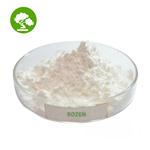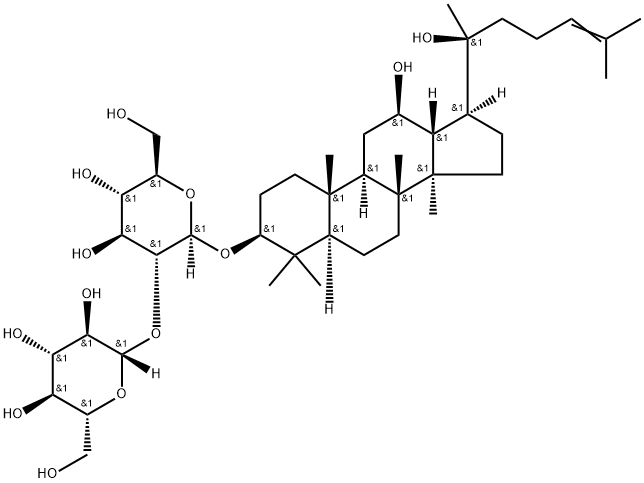Ginsenoside Rg3: Potential and Molecular Mechanisms of in Cancer Treatment
Apr 8,2024
General Description
Ginsenoside Rg3, specifically the 20(S) epimer, exhibits potent anti-cancer properties by inducing apoptosis, inhibiting proliferation, and suppressing key signaling pathways. It shows efficacy in various cancer types by modulating Bcl-2/Bax ratio, destabilizing mutant P53, and inhibiting NF-κB activation. Moreover, Ginsenoside Rg3 demonstrates significant anti-angiogenic effects by reducing migration, invasion, and angiogenesis through MMP inhibition and modulation of key angiogenic factors and signaling pathways. Overall, the distinct effects of 20(S)- Ginsenoside Rg3 make it a promising candidate for cancer treatment, offering a multifaceted approach against cancer progression.

Figure 1. Ginsenoside Rg3
Potential in the Treatment of Cancer
Ginsenoside Rg3, a natural compound found in ginseng, has shown promising potential in the treatment of cancer due to its distinct effects on different biological systems. There are two epimers of ginsenoside Rg3, 20(S)- and 20(R)- Ginsenoside Rg3, each with specific characteristics and activities. In studies, it has been observed that 20(S)- Ginsenoside Rg3 exhibits potent inhibitory effects on various receptors and channels, such as 5-HT3A, α3β4 nACh receptors, and voltage-dependent Ca2+, K+, and Na+ channels. This epimer has been found to be a superior scavenger of hydroxyl radicals and has demonstrated the ability to induce apoptosis in human gastric cancer cells by activating caspase-3, -8, and -9. Moreover, in human hepatocellular carcinoma cells, 20(S)- Ginsenoside Rg3 effectively inhibits cell growth, downregulates DNA methyltransferases, reduces global DNA methylation, and modifies the methylation of key genes involved in cancer progression. On the other hand, 20(R)- Ginsenoside Rg3 exhibits antioxidant properties against oxidative stress and enhances the immune response in animal models. It has also shown efficacy in inhibiting tumor growth in hepatocellular tumors. Additionally, in lung adenocarcinoma models, 20(R)- Ginsenoside Rg3 has been found to inhibit epithelial-mesenchymal transition by regulating the expression of E-cadherin, vimentin, and Snail. Overall, the distinct effects of 20(S)- and 20(R)- Ginsenoside Rg3 make them potential candidates for further exploration in cancer treatment, offering a multifaceted approach to combating cancer through various mechanisms at the molecular level. 1
Molecular Mechanisms in Cancer Treatment
Induction of Apoptosis and Inhibition of Proliferation
Ginsenoside Rg3, particularly the 20(S) epimer, demonstrates significant anti-cancer properties through multiple mechanisms. It induces apoptosis in cancer cells by activating caspase-3, degrading PARP, and modulating the Bcl-2/Bax ratio. Additionally, Rg3 inhibits NF-κB activation by suppressing the phosphorylation of Akt and ERK, leading to decreased cell proliferation and increased apoptosis. In MDA-MB-231 cells, Ginsenoside Rg3 destabilizes mutant P53, downregulates Bcl-2 expression, and promotes apoptosis. Moreover, Ginsenoside Rg3 has been shown to inhibit tumor growth in various cancer models, including colon, lung, liver, pancreas, gallbladder, ovary, melanoma, and more. In vitro studies further support the role of Ginsenoside Rg3 in inducing cell cycle arrest and inhibiting proliferation in breast cancer cell lines like MCF-7. Overall, Ginsenoside Rg3 exerts its anti-cancer effects through a comprehensive approach involving apoptosis induction, proliferation inhibition, and modulation of key signaling pathways. 2
Inhibition of Migration, Invasion, Angiogenesis, and Metastasis
Ginsenoside Rg3 demonstrates potent anti-angiogenic effects both in vitro and in vivo. It reduces migration, invasion, and angiogenesis of human umbilical vein endothelial cells (HUVECs) through various mechanisms. Treatment with 20(R)-Ginsenoside Rg3 significantly reduces HUVEC viability, inhibits tube formation, and suppresses VEGF-induced chemo-invasion in a dose-dependent manner. In vivo studies using matrigel plug assays further confirm the anti-angiogenic properties of Ginsenoside Rg3. Mechanistically, Ginsenoside Rg3 inhibits matrix metalloproteinases (MMP-2 and -9), decreases serum levels of IGF-1, and reduces the expression of CXCR4 in breast cancer cells, thereby inhibiting migration and invasion. Additionally, Ginsenoside Rg3 has been shown to modulate the expression of various factors involved in angiogenesis, including MMPs, HIF-1α, AQP1, HDAC3, TGF-β1, and VEGF, as well as key signaling pathways such as NF-κB, p38 MAPK, ERK, and EGFR-mediated pathways. These findings collectively highlight the multi-faceted anti-angiogenic effects of Ginsenoside Rg3, making it a promising candidate for anti-cancer therapy across various cancer models. 2
Reference
1. Wu R, Ru Q, Chen L, Ma B, Li C. Stereospecificity of ginsenoside Rg3 in the promotion of cellular immunity in hepatoma H22-bearing mice. J Food Sci. 2014; 79(7): H1430-H1435.
2. Nakhjavani M, Hardingham JE, Palethorpe HM, et al. Ginsenoside Rg3: Potential Molecular Targets and Therapeutic Indication in Metastatic Breast Cancer. Medicines (Basel). 2019; 6(1): 17.
- Related articles
- Related Qustion
- Ginsenoside Rg3: mechanism of action, pharmacodynamic and safety Nov 10, 2023
Ginsenoside Rg3 inhibits angiogenesis through VEGF/VEGFR2 modulation and shows safe profiles in studies.
- Anticancer effects of ginsenoside Rg3 Oct 23, 2019
Ginsenoside Rg3 may be a widely applied natural medicine against cancer. To date however, there is no systematic summary available of the anticancer effects of ginsenoside Rg3. Therefore, in this review, all available literature over the pa
Arbidol, a Russian-developed antiviral, shows promise in treating respiratory diseases, but requires further research for long-term safety and efficacy.....
Apr 8,2024APIEthyl-2,2-dimethyl-7-bromoheptanoate is crucial for bempedoic acid synthesis, ensuring high efficiency and purity, advancing pharmaceutical synthesis methodologies.....
Apr 8,2024APIGinsenoside Rg3
14197-60-5You may like
- Ginsenoside Rg3
-

- $0.00 / 25kg
- 2024-04-12
- CAS:14197-60-5
- Min. Order: 1kg
- Purity: 98%
- Supply Ability: 2000ton
- Ginsenoside Rg3
-

- $0.00 / 20mg
- 2023-02-24
- CAS:14197-60-5
- Min. Order: 5mg
- Purity: ≥96%(HPLC)
- Supply Ability: 10 g
- Ginsenoside RG3 Natural Plant Extracts HPLC 15% 50% 98% 14197-60-5
-

- $365.00 / 1g
- 2022-02-14
- CAS:14197-60-5
- Min. Order: 10mg
- Purity: 15% 50% 98%
- Supply Ability: 100.00kgs




